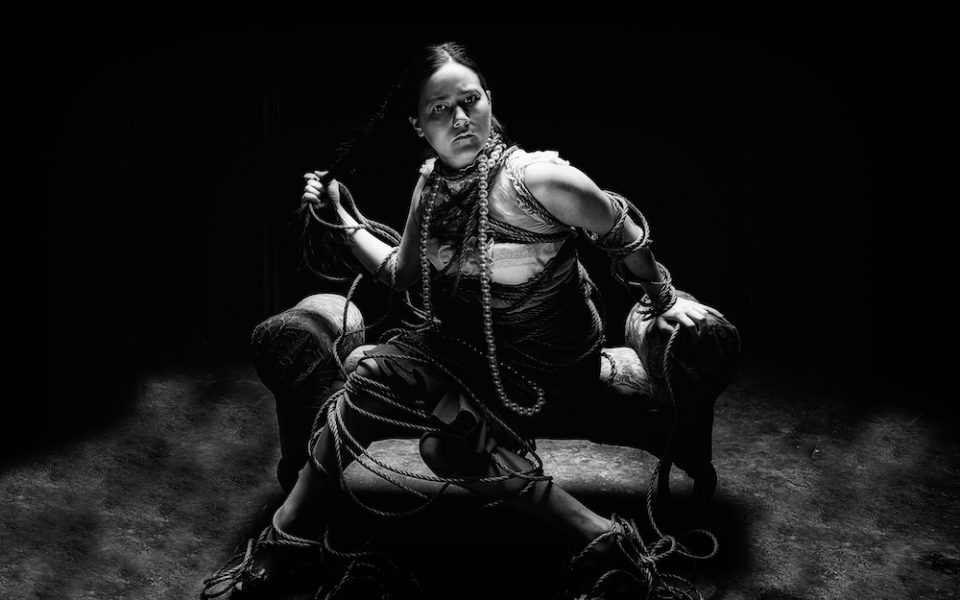Little fragments of rope fill a wicker basket in the gallery at the Sawtooth School for Visual Art. Strong and made of plastic, the same type of rope snakes around models in the large, dramatic photographs that line the walls.
“Lynching rope.”
That’s what artist Owens Daniels calls the rope but that’s not what it’s about.
“Think about what the rope means to you,” Daniels says, as he hands me a 5-inch piece. “My job in my mind was to take away the negative thing about the rope. Take away the idea that this is about lynching, but still use it to shock you into saying, ‘What is this about?’”
In “Look at Me,” a woman dressed in fine clothing adorned with pearls casts an icy stare at the onlooker, her eyes challenging the viewer to look away. She’s hovering over an armchair, and rope wraps around her body as she struggles to break free . The strands curl around her feet, her legs, her arms, until it wends its way to her hands, which grasp the coiled tendrils, struggling for, demanding, independence.
“It’s this idea that this woman has to be perfect in two different ways,” Daniels explains. “Her heterosexual relationship has to be perfect. She wears pearls and leads a perfect life. The rope represents her other life in a really aggressive relationship with another woman. But she’s saying, ‘I want to be seen.’”
While the imagery may not tell the full story that Daniels paints with his words, his exhibit, Common Ties That Bind, illustrates the different ways each of us is tied or bound to things in our lives.
“The idea of being tied to something means you still have independence,” Daniels says. “You still have control but if you are bound to something, you have to submit to what you’re bound to.”
The Winston-Salem-based artist said that the idea for the exhibit came from stories he’d see in the media and revolves around things like racism, the #MeToo movement, transgender rights and more.
“This exhibit, when you first walk in, you feel compelled,” says Amy Jordan, the executive director at Sawtooth. “He wants you to ask those questions and think about those different labels and things that bind us. Every person has a different story and they’re gonna see something different.”
In “Zeus,” the rope exists within the photograph itself but also pours out of the canvas and into our world. Like leaves on a willow tree, the ropes that wrap around the black man’s arms, neck and shoulders hang from holes cut in the canvas and pool underneath the work on the floor.

The protagonist represents Jesse Washington, a black man who became famous as the victim of a brutal public lynching in 1916. The event was one of the first well-documented lynchings in the country.
Daniels says he titled the work “Zeus” to challenge the idea of Washington as merely a mutilated body and a product of horrific racism.
“What would he look like if he resurrected himself out of that brutality?” Daniels asks. “Would he look like Zeus, a Greek god?”
Daniels says Common Ties challenges preconceived notions that people might have about others, but also about themselves.
“One of the biggest binds that I would find in life is your generation,” says the 60-year-old artist. “Traditions and cultures are changing; they are fading away; they are burnt before your eyes, they are melting away and you want to hold onto that. But you are bound to that when you’re inflexible.”
These days identity politics has people labelling themselves as liberal or conservative or feminist or activist, but Daniels urges people to take a step back and ask themselves what those labels and ties mean.
In doing so, he likens his life and his experiences to a tree.
“The top of the tree is way different than the bottom of the tree,” he says. “I feel tied because I’m an artist. I can see the world from the top of the tree as an artist. When I’m a black artist, male artist, that’s the trunk of the tree. I’m bound to that. Not in a negative way but that’s me. I question myself all the time: Are you growing?”
Daniels says that as a black male artist, he sometimes gets pigeonholed into portraying life in a certain way whether that be about race or slavery. But he says art gives him the freedom to pursue anything he wants. He isn’t bound to his identity.
“Art to me is freedom,” he says.
Lately, Daniels, who has mostly worked in photography, has tried his hand at mixed-media work, which can be viewed in this exhibition.
“The idea is to take this message of commonality,” he says. “You think, ‘Am I tied to the idea that it’s gotta be this way?’ The commonality of our experience is visualized.”
Common Ties That Bind will be on display at Sawtooth School for Visual Art until Aug. 23. Find out more about the exhibit online.
Join the First Amendment Society, a membership that goes directly to funding TCB‘s newsroom.
We believe that reporting can save the world.
The TCB First Amendment Society recognizes the vital role of a free, unfettered press with a bundling of local experiences designed to build community, and unique engagements with our newsroom that will help you understand, and shape, local journalism’s critical role in uplifting the people in our cities.
All revenue goes directly into the newsroom as reporters’ salaries and freelance commissions.


Leave a Reply